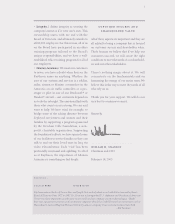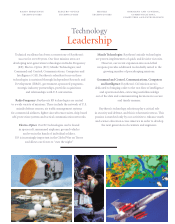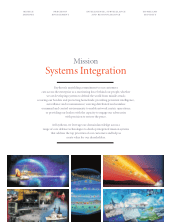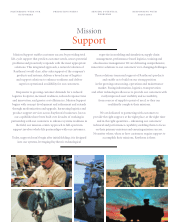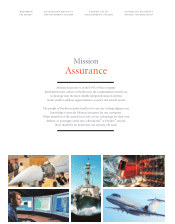Raytheon 2004 Annual Report Download - page 15
Download and view the complete annual report
Please find page 15 of the 2004 Raytheon annual report below. You can navigate through the pages in the report by either clicking on the pages listed below, or by using the keyword search tool below to find specific information within the annual report.
Space and Airborne Systems (SAS), with 2004 sales of
$4.1 billion, is a leader in the development of advanced
sensor technology for radar and targeting systems, inter-
planetary exploration, classified programs and electronic
warfare equipment.
•SAS will supply surveillance radar and coun-
termeasures for the Multi-mission Maritime Aircraft.
•Development of Active Electronically Scanned
Array (AESA) radar systems for U.S. Navy and U.S. Air
Force aircraft is an important mission of SAS.
Revolutionary AESA systems, the result of a quantum
leap in radar technology that employs no moving parts
and scans at nearly light speed, are deployed with an F-15
squadron and are in flight test on the F/A-18. The U.S.
Air Force is using Raytheon AESA technology in a radar
upgrade program for the B-2. The Multi-platform Radar
Technology Insertion Program offers a modular AESA
system scalable in size for use on manned and unmanned
U.S. Air Force platforms.
•Innovation in electro-optical and infrared
technology yields targeting systems on which U.S. forces
rely. The Advanced Targeting Forward-Looking Infrared
(ATFLIR) system merges three capabilities in a single pod,
offering unequaled magnification, imagery and immediacy
in a television format of exceptional clarity for all F/A-18
aircraft. The Multi-spectral Targeting System combines
infrared cameras, lasers and electro-optical sensors for
many kinds of manned and unmanned aircraft. These
systems permit rapid employment of precision-guided
weapons with a high likelihood that they will strike
their targets.
•A pair of SAS spectrometers measures infrared
radiation on Mars in a hunt for signs of water. Evidence
of minerals formed in the presence of the liquid could
help scientists determine whether life has occurred on
the planet.
•In a major electronic warfare (EW) program,
SAS is developing a self-protection suite of EW equipment
and systems for the Hellenic Air Force.
•Military and government customers depend
on SAS systems and solutions for success in the unforgiv-
ing environment of air and space. The people of SAS are
equally demanding of themselves in performing on pro-
grams and promises in order to deliver products and
services that work every time and meet projected costs
and schedules.
․․․․․․․․․․․․․․․․․․․․․․․․․․․․․․․․․․․․․․․․․․․․․․․․․․․․․․․․․․․․․․․․․․․․․․․․․․․․․․․․․․․․․․․․․․․․․․․․․․․․․․․․․․․․
The Advanced Targeting Forward-Looking Infrared (ATFLIR) pod replaces
with unsurpassed clarity the inferior resolution of images produced by a
mechanically scanning focal plane array. SAS is meeting its current
commitment to deliver two pods per month to the U.S. Navy, which plans to
purchase up to 574 units for use on all F/A-18s. SAS is prepared to meet
requirements for delivery of four units per month in 2005, and six units per
month in 2006. The business expects to increase the monthly production
capacity at its 32,000-square-foot ATFLIR assembly facility to 12 pods by
June 2005 to accommodate international sales and customer demand.
․․․․․․․․․․․․․․․․․․․․․․․․․․․․․․․․․․․․․․․․․․․․․․․․․․․․․․․․․․․․․․․․․․․․․․․․․․․․․․․․․․․․․․․․․․․․․․․․․․․․․․․․․․․
Space and Airborne Systems
President
“At SAS our stock in trade is mission assurance, meaning our
products must work any place, any time our customers use
them. For the men and women of SAS, customer success truly
is our mission.”


